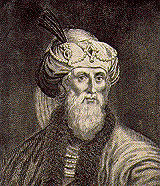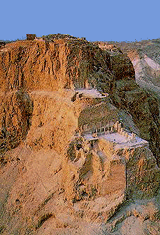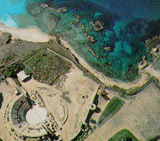 |

Educational Reference
Series |

by Magen Broshi
The Israel Museum, Jerusalem
|
|
Our knowledge of the last two centuries of the Second Commonwealth depends very substantially on the writings of Josephus. Matters such as his credibility, accuracy and sources are therefore foremost among the topics which should occupy scholarship.
Archaeological Data
|

1 It is not exactly clear to which stadium Josephus refers; in his day several standards were in use. See H. Prell, Die Stadienmasse des Klassischen Hochschule Dresden 6 (1956/57) Heft 3, pp. 549-563. If however Grafman's contention is correct that the Herodian foot measured 31 cm, the stadium in this case could well equl 186m (i.e. 600X31cm). See R. Grafman, Herod's Foot and Robinson's Arch, IEJ 20 (1970) pp. 60-66. It would then correspond with the standard Roman stadioum (according to Prell, above, 185.6m), which agrees with our conclusion.
2Y. Yadin, "The Excavations of Masada - 1963/64 Preliminary Report", IEJ 15 (1965), p. 69 and note 45; see also the remarks of M. Avi-Yonah, "The Archaeological Survey of Masada, 1955-1956", IEJ 7 (1957), pp. 52-54.
3From the plan published by the excavators it can be computed that the length of the wall measured some 3500m. See also J. W. Crowfoot et. al., The Buildings at Samaria, London 1942, pp. 39-40 and pl. I.
4 M. Avi-Yonah, Sepher Yerushalaim I, Jerusalem and Tel Aviv 1956, p. 319 (Hebrew).
5 A. Raban has made an extensive survey of Caesarea's harbour. The results, to be published soon in Qadmoniot XIV, 3-4 (1981), confirm the basic description of Josephus.
6 Cf. Avi-Yonah, ibid. (supra, note 2), 99. 51ff.
7 Cf. Yadin, ibid. (supra, note 2), p. 69, note 47.
|
The most obvious data for examination, it would seem to us, is archaeological material. In many instances, numerous details provided by Josephus can be checked, including architechural data, and their accuracy confirmed. Such precision, where it can be established, is surprising, especially since the information was set down in writing years after Josephus had left Palestine. In addition, it is clear that in some cases he is describing objects that he cannot possibly have seen, let alone measured. Thus he probably never visited Masada or set foot on its summit, so he cannot himself have measured its walls. For sixty years preceding the Great Revolt, the desert fortress was occupied by a Roman garrison and civilians were not normally allowed entry. Even so, he writes in War (VII, 286) that the walls of Masada were seven stadia, i.e., about 1300m. long.1 And so indeed they were.2 Similarly, he describes in War (I, 403) the walls of Samaria-Sebaste, built by Herod, as being twenty stadia long (3720m.). This figure also approximates to their length as unearthed.3
The perimeter of the walls of Jerusalem is said by Josephus (War V, 159) to extend to thirty-three stadia (6138m.), whereas in Avi-Yonah's reckoning they were 5550m. long; but this is a difference of merely 10%.4
Again, the harbour of Caesarea built by Herod has been studied meticulously by A. Raban and he finds that Josephus's account of it is by and large correct.5 At Masada, too, the description of the northern palace (which Josephus calls the western palace, War VII, 286) matches the remains as discovered.6 The same my be said of the width of the wall, eight cubits, which is close to 4 m. (War VII, 286).7 On the other hand, the historian alludes to thirty-seven towers on the walls of Masada (War VII, 287), whereas only twenty-seven were identified during the excavations. Either the excavators were unable to recognize all the towers, or Josephus's work contains a textual error, which may possibly be the fault of a copyist.8
Further perusal of Josephus would undoubtedly reveal additional instances of similar archaeological data.9
Other data
|
8 Idem, ibid., p. 70.
9 The description of Machaerus (War Vii, 164-189) is quite accurate. Cf. V. Corbo, Liber Annuus 28 (1978), pp. 224-226. There is good reason to believe that this too is based on the commentaries (see below).

10H. St. J. Thackeray (in his translation in the Loeb Library, note b to this passage) is wrong in trying to correct Josephus' figures.

|
In Josephus's War, much of the data can be proved accurate and much of the rest reliably assumed to be so. They cannot always be ascribed simply to keen observation (cf. Masada) or to an exemplary memory (cf. The dates of minor military events). Thus in regard to geographical data, which can be checked exactly, the distances he gives are very often quite right. Jerusalem is said to lie 150 stadia from Jericho (about 30 km), and Jericho 60 stadia (some 12 km) from the Jordan (War IV, 474).10 The distance between Jerusalem and Herodium is described as 60 stadia (about 12, km, War I, 265); from Jerusalem to Gibeon, 50 stadia (10 km, War II, 516); and to Gibeah of Saul, 30 stadia (about 6 km, War V, 51). All these figures are reasonably accurate.
Another type of data concerning numbers of people cannot readily be verified but seems nevertheless reliable. Josephus' tendency grossly to exaggerate population figures is well known. Thus the inhabitants of Galilee are reckoned at more than three million (War VI, 420). Josephus himself sensed that these numbers were incredible. Yet he outdoes even himself in His estimate, in the last cited passage, that in the census carried out under Cestius celebrants at the Passover sacrifices amounted to more than two million seven hundred thousand. At the same time this very same Josephus also gives modest round numbers likely to be quite correct. His information relating to the defenders of Jerusalem (War V, 248) is an example of such reasonableness, namely that Simon son of Giora led ten thousand warriors and five thousand Idumeans, that John of Gischala commanded six thousand warriors, and that tow thousand for hundred Zealots also joined him, and that the total involved was twenty-three thousand four hundred men. Another seemingly reliable figure is that of the ninety-seven thousand captive taken by the Romans in Jerusalem (War VI, 420). These numbers stand out among inflated figures such as that of the corpses removed through one of the gates during the fifty days between May 1 and June A.D. 20, viz., one hundred and fifteen thousand eight hundred and eighty (War V, 567: dates according to Niese). This precise number may appear credible but is in fact quite impossible.11
|
|
11 On the population of Jerusalem see my paper 'La population de l'ancienne Jérusalem', Revue biblique 82 (1975), pp. 5-14.
|
The Source of Josephus' Accurate Data:
The Commentaries
Undoubtedly, the source of much of Josephus's accurate data was the Roman imperial commentaries, the hupomnemata, specifically mentioned by him three times in his later works. Thus he answers Justus' accusations with the words: "Neither were you a combatant nor have you perused the commentaries of Caesar, as is abundantly proved by your contradictory account" (Life, 358). Similarly against Justus he maintains: "This is no unsupported assertion of my own. The facts are recorded in the commentaries of the Emperor Vespian" (Life 342). Finally, we read: "Even if, as they (Josephus' critics) assert, they have read the commentaries of the imperial commanders, they at any rate had no first-hand acquaintance with our position in the opposite camp" (Against Apion, 56). Josephus does not actually state that he has read the Commentaries but he clearly made direct use of them. Moreover, as will be seen later, he drew material from them for his own writings, especially War, his earliest book.
What were these commentaries? According to one of the two principle schools of thought concerning them, the latest proponent of which is Bardon, they were memoirs written by Vespasian. Bardon admits that no such work is mentioned by the Roman historians, and expresses surprise that Vespasian should have shown any inclination for writing or found the time for it; but almost every emperor between Augustus and Nero did write
|
|
12 Henry Bardon, Les empereurs et les lettres latines d'Auguste á Hadrian, Paris 2 1968, pp. 271-272. W. Weber is basically close to the first school. He was of the opinion that Josephus made use of a Flavian composition - a composition not written by the emperor (Vespasian or Titus) but an official record based on crude field reports. Cf. Josephus und Vespasian. Untersuchungen zu dem jüdischen Krieg des Flavius Josephus, Berlin 1921, passim.
13 H. St. J. Thackeray, Josephus, the Man and the Historian, New York 1929, pp. 38-40. There is no point in enumerating all the holders of this theory but see R. J. H. Shutt, Studies in Josephus, London 1961, pp. 26-29.
14 A. von Gutschmid, Kleine Schriften 4, Leipzig 1893, p. 346.
15 E. Schurer - G. Vermes - F. Millar, The History of the Jewish People in the Age of Jesus Christ I, Edinburgh 1973, p. 33.
16 A useful study dealing inter alia with the history of research is H. Lindner, Die Geschichtsauffassung des Flavius Josephus in BJ, Leiden 1972.


Masada
|
memoirs.12 The other school is of the opinion that the commentaries were field reports of military commanders, in draft form or slightly edited.13
The second view seems preferable, primarily because, as already noted by von Gutschmid, in the proemium to War Josephus castigates the available history books, an action unthinkable of a work by his patron, Vespasian, had figured among them.14
Those who subscribe to the first theory suggest as another solution that the emperor's books was not published until after Josephus had completed writing War.15 But on the basis of the evidence already given here, there can be little doubt that he had them before him whilst working on the book. Moreover, the commentaries appear to have been used mainly during the composition of War; he seems to have resorted to them much less frequently, and possibly not at all, in his later works.16 But why does he not mention the commentaries in War? We share the opinion of those who believe that he avoided referring to them because he wished to emphasize his own status as an eye-witness. He wished to impress on his readers that he was no mere compiler relying on the evidence of others. "The industrious writer is not one who merely remodels the scheme and arrangement of another's work, but one who uses fresh materials and makes the framework of the history his own" (War I, 15). He can hardly be expected to have admitted using the works of others after a statement such as this. It should be noted also that it is in his later writings that Josephus mentions the assistance he received in composing his Greek text, although it would surely have been in his first book that he would have most needed such help.
Further Use of the Commentaries
Having in Section A noted archaeological data drawn from the commentaries, and in Section B, data which should probably be ascribed to military reports, geographical details and population statistics, two further types of evidence ascribed to the commentaries have now to be discussed, namely information relating to Roman military deployment throughout the empire and to military exploits and their dates.
The speech of Agrippa II (War II, 345 ff.) has been studied thoroughly and von Domaszewski has found confirmation of
|
17 A. von Domaszewski, 'Die Dislokation des römischen Heeres im Jahre 66 n. Ch., Rheinisches Museum N.F. 47 (1892), pp. 207-218.
18 G. Ricciotti, Flavio Giuseppe II Turin, 3 1963, pp. 264-71 (after Lindner).


Caesarea
|
the account it provides of the disposition of the Roman army.17 Recently, is has been claimed that this text does not reflect the situation in A.D. 66 but rather that of around A.D. 75,18 which would indicate – as we would in any case have assumed – that Josephus relied on commentaries dating not only from the period of the Great War but also on later commentaries found by him in the imperial archives.
Detailed reports on the activities of the Roman army and its various units appear at several other points in Josephus' works, for instance in his description of Titus's march from Alexandria to Caesarea (War IV, 658-663), and in the listing, which bears the stamp of an actual military document, of Cestius' forces and their composition (War II, 499-503). Josephus can scarcely have invented such matters or recorded them from memory, his own or another's. But the commentaries were not the source for "great" events alone. Many of the battle annals, even their minor details, smack of military field reports. An example is the account of the physique, looks, etc., of Sabinus the Syrian soldier who scaled the wall (War VI, 54-67). It has the sound of a story told by military scribes, a tale on the basis of which medals were awarded.
On Josephus' Accuracy
Was Josephus always correct? Certainly not. His inaccuracies range from vagueness to blatant exaggeration. Shaye Cohen |
19 S. J. D. Cohen, Josephus in Galilee and Rome, his Vita and Development as a Historian, Leiden 1979, p. 233.
20 Idem, ibid., index s.v. Josephus (p, 276).
21 Idem, ibid., pp. 33-34.
22 Cf. O. Betz, in A. Oppenheimer - U. Rappaport - M. Stern (eds.), Jerusalem in the Second Temple Perios, Abraham Schalit Memorial Volume, Jerusalem 1980, p. 84 (Hebrew).

23 W. F. Albright, JOR 22 (1931-32), p. 411.
24 L. H. Vincent - A. M. Stève, Jérusalem de l'Ancien Testament I Paris 1954, p. 145, n.1.
25 Idem, ibid., p. 144, n.2.

26 The author wishes to express his thanks to Dr. A. Eran and Professor M. Stern for their valuable suggestions.
|
accuses him of "inveterate sloppiness".19 The index to Cohen's book goes so far as actually to include entries for "exaggeration", "inconsistency and sloppiness" and "corrupt transmission of names and numbers".20 Indeed, even if it is accepted that copyists were responsible for not a few of his mistakes (some of which have been hinted at already), it still cannot be denied that he was by nature somewhat negligent.21 The list of scholars who have deprecated his errors is long22 but suffice it to mention here the accusations of tow eminent archaeologists alone, since archaeology is the central theme of the present discussion. Albright remarks on "how inaccurate Josephus generally was in details . . ."23 Vincent goes even further. "Il serait superflu", he maintains, "d'accentuer de nouveau la futilite de toute evaluation fondee sur les chiffres de Josephe."24 However, a remark on the previous page, to the effect that a particular item of information is an "excellente approsimation",25 reflects the reaction typical of scholars investigating Josephus' data.
This duality of sharp criticism alongside fulsome appreciation has consistently accompanied the scholarly treatment of Josephus' works. It has not been our intention here to prove that he is always exact of correct in every statement, but to show that his data are in many instances accurate, and that they stem from reliable sources to which he had access from the very beginning of his literary career.26
This article first appeared in Journal of Jewish Studies: Essays in Honor of Yigael Yadin in 1982 by the Oxford Centre for Postgraduate Hebrew Studies.
|



